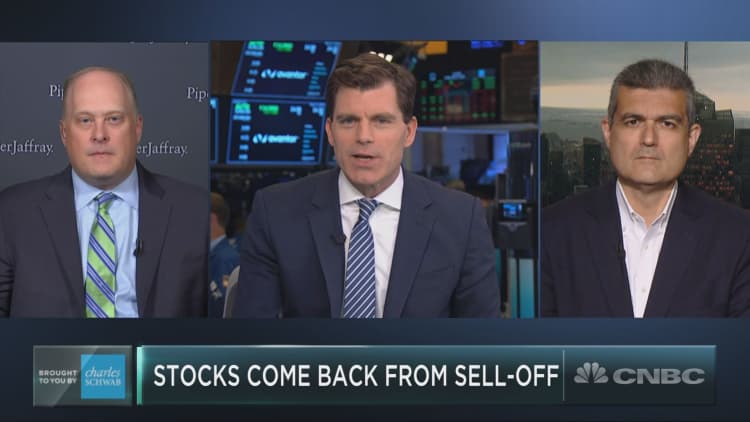
The stock market has so far withstood its ongoing "gut check," with a three-day bounce after last Monday's mini-tariff-panic sell-off, preserving its longer-term uptrend and leaving the S&P 500 about 3% from its recent record highs.
Still, for a market so close to all-time heights, its resilience to date owes a lot to cautious, risk-evading behavior rather than optimistic conviction about the future.
Stocks have been supported to a significant degree by compressed Treasury yields, which themselves embed high market-implied odds of a Federal Reserve interest-rate cut within months. Such a move by the central bank would come about only in response to waning economic momentum and a rollover in inflation trends.
Here, Bespoke Investment Group illustrates the way the has lately failed to follow 10-year Treasury yields down after tracking them fairly well for a while.
There's nothing ironclad about the interplay of equities and bond yields — the relationship shifts across market phases. But this at least shows stocks have found a way to hang above the 2,800 zone — once viewed as the ceiling of a sloppy, treacherous trading range — as Treasury yields have succumbed to a global risk-aversion impulse.
What are investors betting on?
One way the S&P has managed this is to lean heavily on more stable, less cyclical stocks. This means turning back toward the familiar favorites of FANG — those organically growing, software-powered giants with fewer bets on China and less sensitivity to macro headwinds.
The FirstTrust Dow Jones Internet ETF (FDN), a good proxy for FANG-type stocks, is up 21% this year to 14% for the S&P 500. The iShares Software ETF (IGV) is ahead by 24% for 2019. Since the day exactly two months ago when the 10-year Treasury broke down below 2.6% toward its current 2.39% level, IGV is up 2.9% to the S&P's 1.2% gain.
Another popular hiding place is "low-volatility" stocks — stable companies' slower-moving shares, which act somewhat like bonds. Here's the Invesco S&P Low-Volatility ETF (SPLV, in red) against the S&P 500 (green) and the Invesco S&P High-Beta ETF (SPHB, blue) over the past month. In other words, the stock market has been held up by stocks that behave less like stocks than most stocks.
Aside from sector divergences, the small-cap Russell 2000 continues to underperform badly, while the rise in risk-aversion can also be seen in the Japanese yen and Swiss franc moving higher in recent weeks.
In a way, the strength in steadier, blue-chip U.S. stocks is not inconsistent with sinking global bond yields and gains in safe-haven currencies. On some level, large-cap American equities are on the same "relatively expensive but higher quality" end of the asset spectrum.
Risk-shunning attitude
The tariff escalation could easily be viewed mostly as an excuse for a standard shakeout after a 25% rally since December, just in time to keep complacent investor sentiment and positioning from stretching all the way to extreme and self-undermining overconfidence.
Two choppy, headline-tossed weeks for stocks have gone some distance toward moderating gathering mood, with a risk-shunning attitude evident in investor surveys and fund flows.
While a bit fickle and narrowly sampled, the weekly American Association of Individual Investors poll showed one of the eight largest jumps in bearish respondents in a decade, with more bears than bulls.
This is echoed by significant drops in optimism in professional-investor sentiment gauges kept by Consensus Inc. and Market Vane toward neutral readings from multimonth highs just two weeks ago.
Outflows from equity mutual and exchange-traded funds has been more the rule than not this year, suggesting the fourth-quarter collapse in stocks has had a lasting effect on investor attitudes.
Ned Davis Research shows this heavy pace of withdrawals against the S&P 500, which goes down as a bullish factor from a contrarian perspective.
The latest flare-up in trade friction with China has rubbed a raw nerve among investors, who explained stocks' steady climb through April as a story of big threats fading from view: The onrushing recession feared in December is not in evidence; the Fed has backed away from rate hike plans; corporate earnings arrived better than forecast; and, until two weeks ago, the U.S.-China trade tussle looked near a benign resolution.
After last Monday's 2.5% sell-off, stocks showed signs of again trying to set aside the trade issue, which — for all its drama over the past two years and the high perceived stakes — has not been able to hold the market hostage for long stretches of time.
The bounce that started Tuesday allowed the S&P to narrow its weekly loss to 0.8%. On a net basis, the market was up during regular trading hours, with overnight weakness dropping the indexes at the open, only to have buyers pick them up in the regular session.
The makeup of the rebound was not all that impressive, granted. Market breadth continues to lag a bit, with fewer than half of all S&P 500 stocks in a technical uptrend, to cite one soft spot.
(It was the fourth straight negative week for the Dow, and there have not been five straight down weeks for the index since the 2011 minibear market, so the odds hint at some short-term relief.)
The market continues to track the 2016 path, in broad terms: a brutal minibear market gives way to a more dovish Fed and huge stock market rebound even as bond yields stay low, defensive stocks lead and investor sentiment stays muted.
Several months after the early-2016 market bottom, the Brexit vote shock administered a stiff and scary test, proving good enough for only a sharp, brief sell-off before stocks resumed an upward grind. Could the trade-war scare of May prove a similar geopolitical test that doesn't get "resolved" but loses its power to frighten investors so readily?
This is a notion investors need to ponder but the market will have to prove or refute.






